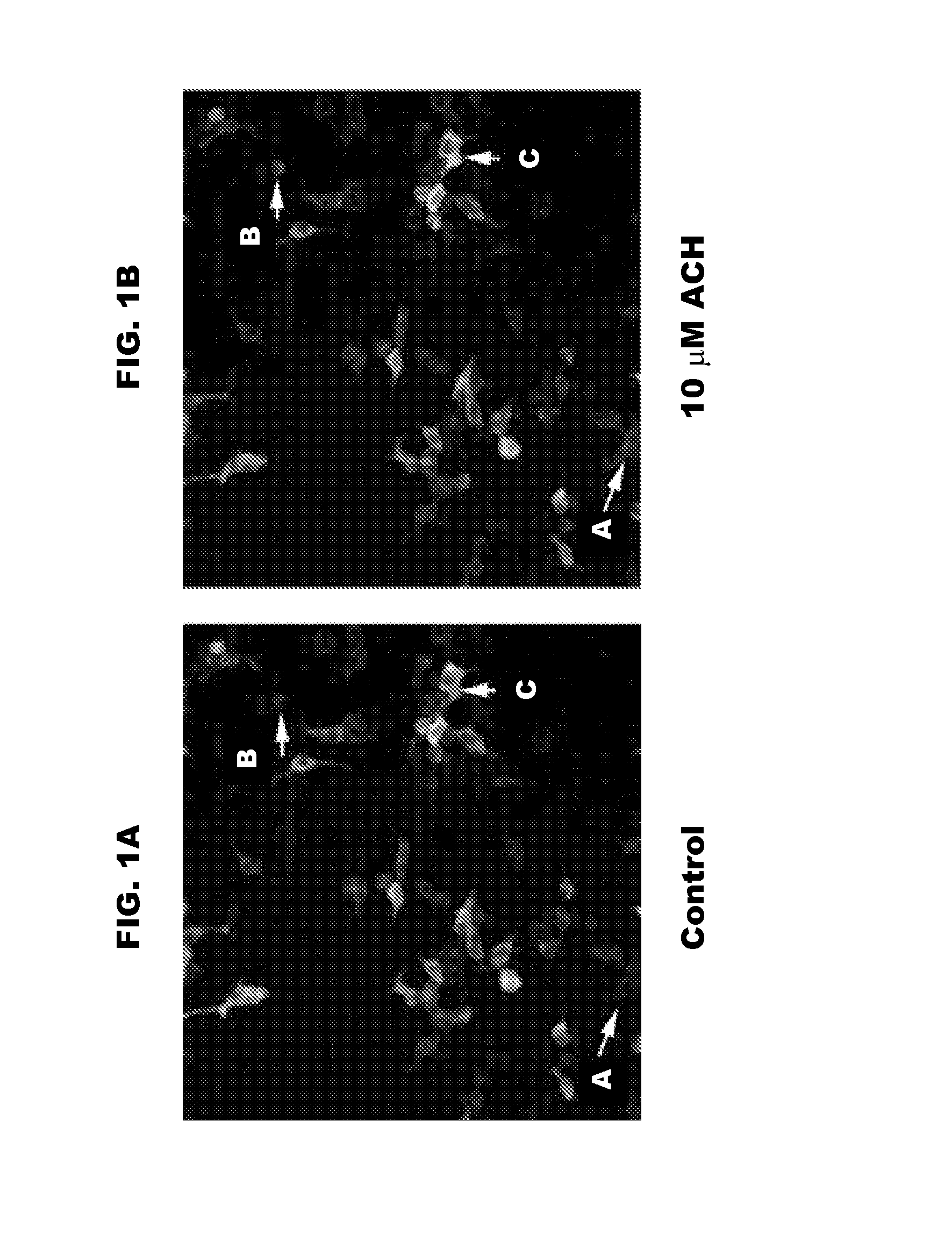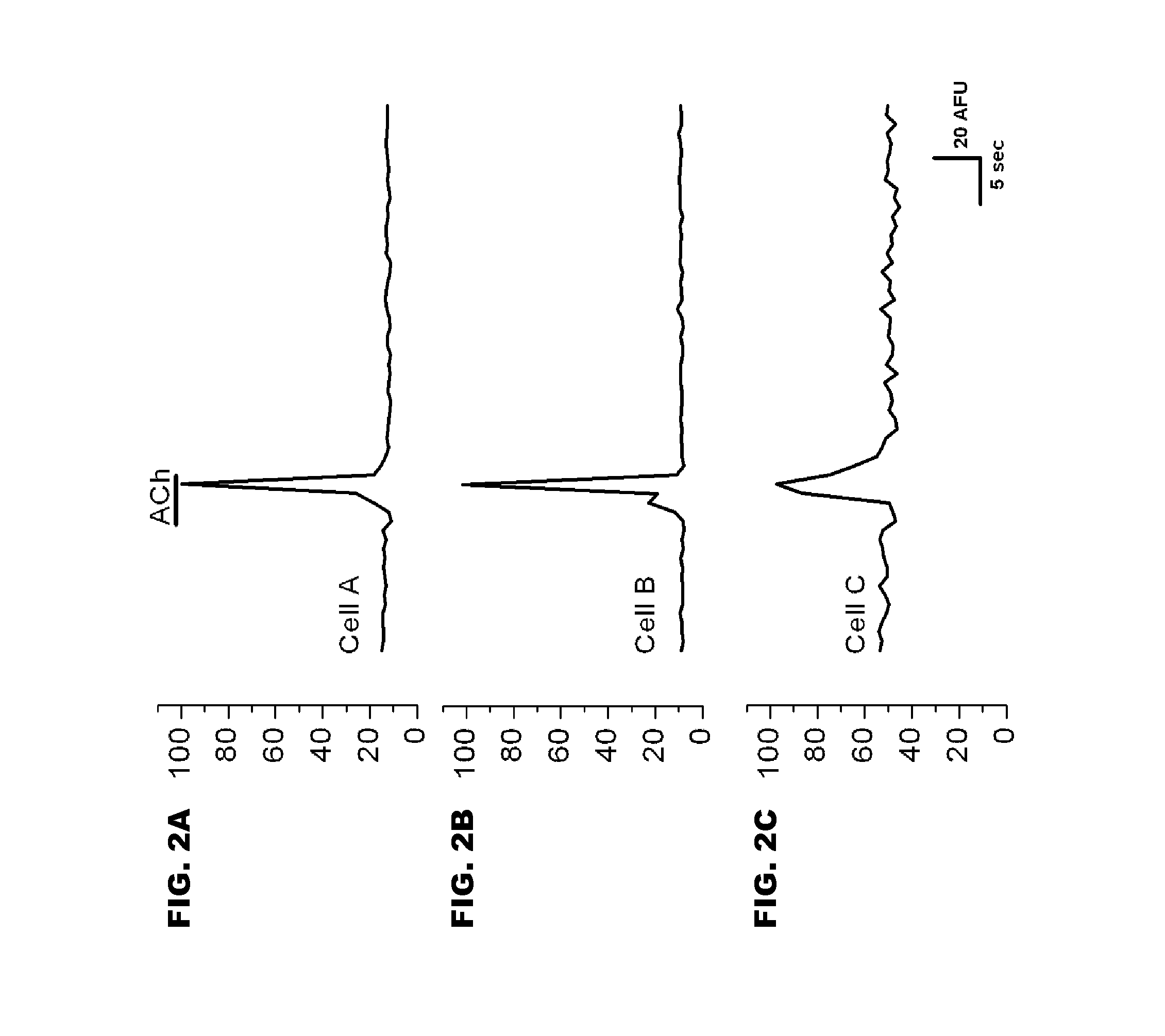Fluorescent mouse model
a mouse model and fluorescent technology, applied in the field of fluorescent mouse models, can solve the problems of compromising the system, unable to provide information for a large number of cells at the same time, and electrical signals offering high temporal resolution
- Summary
- Abstract
- Description
- Claims
- Application Information
AI Technical Summary
Benefits of technology
Problems solved by technology
Method used
Image
Examples
example 1
In Vitro Mammalian Expression of G-CaMP2
[0105]Early versions of G-CaMP were not ideal for mammalian expression systems because they, inter alia, did not fold correctly at physiological temperatures. G-CaMP2, however, is thermally stable and retains brightness at 37° C. These properties of G-CaMP2 were analyzed in vitro using a mammalian expression system. To test the properties of G-CaMP2, human embryonic kidney cells (HEK 293) were transfected with a plasmid containing G-CaMP2 (pN1-G-CaMP2) and incubated at 37° C. for 48 hours. Cells expressing G-CaMP2 exhibited basal levels of fluorescence when excited at 488 nm. Acetylcholine was then used to activate G-protein coupled muscarinic acetylcholine receptors and mobilize intracellular calcium. After treatment with 10 μM acetylcholine, cells expressing G-CaMP2 exhibited an increase in fluorescence, thus allowing an increase in intracellular calcium to be visualized.
example 2
TetO G-CaMP2 Construction
[0106]The properties of G-CaMP2 make it an ideal GES to use to monitor calcium fluctuations in vivo in multiple cell types. In order to increase the ease of using G-CaMP2 in multiple cell types, G-CaMP2 was combined with an inducible system with independent targeting potential. The tetracycline inducible system provides tissue-specific targeting separate from the gene of interest, so multiple cell types may be targeted by only changing one component of the system instead of both components.
[0107]The gene of interest component of the tetracycline inducible system was generated by placing the expression of the G-CaMP2 sensor under the control of the tetracycline promoter (TetO-G-CaMP2) using standard genetic engineering methods (FIG. 3B). The G-CaMP2 used by the invention includes a N-terminal HIS tag of 6 HIS residues (FIGS. 13A and 13B). The tetracycline promoter contains a minimal CMV promoter regulated by 4 tetO sequences (FIGS. 13A and 13B). Transcription...
example 3
Generation of TetO-G-CaMP2 Mouse
[0109]A TetO-G-CaMP2 mouse was generated by linearizing the TetO-G-CaMP2 construct using restriction enzymes. The linearized construct was injected into the pronuclei of fertilized eggs placed in a surrogate mother. From three independent injections, 14 founder mice carrying the transgene were identified by PCR of tail extracted DNA. The 14 founder mice were crossed to a mouse from the OMP-IRES-tTA line (FIG. 3A), which expresses tTA from the OMP allele, targeting it to sensory neurons (FIGS. 7A and 7B). The levels of transgene expression were analyzed in compound offspring of the crosses by examining the number of cells that expressed G-CaMP2 in the olfactory epithelium or the vomeronasal organ. The intensity of fluorescence from individual cells was also assessed as an indicator of the level of expression. G-CaMP2 expression in founder Line 1 (FIG. 4A), Line 3 (FIG. 4B), Line 4 (FIG. 4C), Line 5 (FIG. 4E), Line 8 (FIG. 4D), and Line 10 (FIG. 4F) was...
PUM
| Property | Measurement | Unit |
|---|---|---|
| thickness | aaaaa | aaaaa |
| thickness | aaaaa | aaaaa |
| thickness | aaaaa | aaaaa |
Abstract
Description
Claims
Application Information
 Login to View More
Login to View More - R&D
- Intellectual Property
- Life Sciences
- Materials
- Tech Scout
- Unparalleled Data Quality
- Higher Quality Content
- 60% Fewer Hallucinations
Browse by: Latest US Patents, China's latest patents, Technical Efficacy Thesaurus, Application Domain, Technology Topic, Popular Technical Reports.
© 2025 PatSnap. All rights reserved.Legal|Privacy policy|Modern Slavery Act Transparency Statement|Sitemap|About US| Contact US: help@patsnap.com



